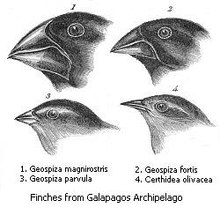Adaptive radiation: Difference between revisions
Wikify image caption |
No edit summary |
||
| (5 intermediate revisions by the same user not shown) | |||
| Line 1: | Line 1: | ||
[[Image:Darwin's finches.jpeg|thumb|Four of the [[Darwin's finches|13 finch species]] found on the [[Galápagos Islands|Galápagos Archipelago]], and thought to have evolved by an adaptive radiation that diversified their [[beak]] shapes to adapt them to different food sources.]] |
[[Image:Darwin's finches.jpeg|thumb|Four of the [[Darwin's finches|13 finch species]] found on the [[Galápagos Islands|Galápagos Archipelago]], and thought to have evolved by an adaptive radiation that diversified their [[beak]] shapes to adapt them to different food sources.]] |
||
'''Adaptive radiation''' describes the rapid [[speciation]] of a single or a few [[species]] to fill many [[ecological niche]]s. This is an [[evolution]]ary process driven by [[mutation]] (heritable/genetic variation) and [[natural selection]]. |
'''Adaptive radiation''' describes the rapid [[speciation]] of a single or a few [[species]] to fill many [[ecological niche]]s. This is an [[evolution]]ary process driven by [[adaptation]] to changed environment and/or [[mutation]] (heritable/genetic variation) and [[natural selection]]. |
||
==Causes of adaptive radiation== |
==Causes of adaptive radiation== |
||
| Line 11: | Line 11: | ||
Isolated [[ecosystem]]s, such as [[archipelago]]s and [[mountain]] areas, can be colonized by a species which, upon establishing itself, undergoes rapid [[divergent evolution]]. |
Isolated [[ecosystem]]s, such as [[archipelago]]s and [[mountain]] areas, can be colonized by a species which, upon establishing itself, undergoes rapid [[divergent evolution]]. |
||
[[Monotremes]] and [[marsupials]] are examples of geographic isolation. Monotremes evolved before the evolution of placental mammals, and they are found today only in [[Australia]], an island. Marsupials, which also evolved before the appearance of placental mammals are also common in Australia. In Australia, marsupials evolved to fill many ecological niches that placental mammals fill on other [[continents]]. |
[[Monotremes]] and [[marsupials]] are examples of geographic isolation. Monotremes evolved before the evolution of placental mammals, and they are found today only in [[Australia]], an island. Marsupials, which also evolved before the appearance of placental mammals are also common in Australia. In Australia, marsupials evolved to fill many ecological niches that placental mammals fill on other [[continents]]. |
||
It is generally agreed that [[bipedalism]] amongst some apes 7 million years ago in Africa was a novel adaptation that led to a new way of living allowing a burgeoning, ie., a number of bipedal species to emerge, of which only homo sapiens, we humans, survived. |
|||
===Extinction=== |
===Extinction=== |
||
| Line 22: | Line 23: | ||
==References== |
==References== |
||
* Leakey, Richard "The Origin of Humankind" 1994 Harper-Collins |
|||
| ⚫ | *Wilson, E. et al. ''Life on Earth,'' by Wilson,E.; Eisner,T.; Briggs,W.; Dickerson,R.; Metzenberg,R.; O'brien,R.; Susman,M.; Boggs,W.; (Sinauer Associates, Inc., Publishers, Stamford, Connecticut), c 1974. Chapters: ''The Multiplication of Species; Biogeography,'' pp 824-877. 40 Graphs, w species pictures, also Tables, Photos, etc. Includes [[Galápagos Islands]], [[Hawaii]], and [[Australia (continent)|Australia]] subcontinent, (plus [[St. Helena]] Island, etc.). |
||
| ⚫ | * Wilson, E. et al. ''Life on Earth,'' by Wilson,E.; Eisner,T.; Briggs,W.; Dickerson,R.; Metzenberg,R.; O'brien,R.; Susman,M.; Boggs,W.; (Sinauer Associates, Inc., Publishers, Stamford, Connecticut), c 1974. Chapters: ''The Multiplication of Species; Biogeography,'' pp 824-877. 40 Graphs, w species pictures, also Tables, Photos, etc. Includes [[Galápagos Islands]], [[Hawaii]], and [[Australia (continent)|Australia]] subcontinent, (plus [[St. Helena]] Island, etc.). |
||
[[Category:Speciation]] |
[[Category:Speciation]] |
||
Revision as of 11:47, 12 February 2007

Adaptive radiation describes the rapid speciation of a single or a few species to fill many ecological niches. This is an evolutionary process driven by adaptation to changed environment and/or mutation (heritable/genetic variation) and natural selection.
Causes of adaptive radiation
Opportunity
Isolated ecosystems, such as archipelagos and mountain areas, can be colonized by a species which, upon establishing itself, undergoes rapid divergent evolution. Monotremes and marsupials are examples of geographic isolation. Monotremes evolved before the evolution of placental mammals, and they are found today only in Australia, an island. Marsupials, which also evolved before the appearance of placental mammals are also common in Australia. In Australia, marsupials evolved to fill many ecological niches that placental mammals fill on other continents. It is generally agreed that bipedalism amongst some apes 7 million years ago in Africa was a novel adaptation that led to a new way of living allowing a burgeoning, ie., a number of bipedal species to emerge, of which only homo sapiens, we humans, survived.
Extinction
Adaptive radiation can also occur after mass extinctions. The best example of this is after the Permian-Triassic extinction event, where biodiversity increased massively in the Triassic. The end of the Ediacaran and the beginnings of multicellular life lead to adaptive radiations and the genesis of new phyla in the Cambrian period.
Adaptive radiation in popular culture
In science fiction sometimes adaptive radiation of humans is imagined. This often makes for interesting multi-species worlds.
References
- Leakey, Richard "The Origin of Humankind" 1994 Harper-Collins
- Wilson, E. et al. Life on Earth, by Wilson,E.; Eisner,T.; Briggs,W.; Dickerson,R.; Metzenberg,R.; O'brien,R.; Susman,M.; Boggs,W.; (Sinauer Associates, Inc., Publishers, Stamford, Connecticut), c 1974. Chapters: The Multiplication of Species; Biogeography, pp 824-877. 40 Graphs, w species pictures, also Tables, Photos, etc. Includes Galápagos Islands, Hawaii, and Australia subcontinent, (plus St. Helena Island, etc.).
